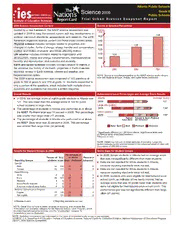
ERIC ED516682: The Nation's Report Card Science 2009 Trial Urban District Snapshot Report. Atlanta Public Schools. Grade 8, Public Schools PDF
Preview ERIC ED516682: The Nation's Report Card Science 2009 Trial Urban District Snapshot Report. Atlanta Public Schools. Grade 8, Public Schools
Atlanta Public Schools Science Grade 8 2009 Public Schools Trial Urba n Dis tr ict Snap sh ot Rep or t 2009 Science Assessment Content Scores at Selected Percentiles Guided by a new framework, the NAEP science assessment was updated in 2009 to keep the content current with key developments in science, curriculum standards, assessments, and research. The 2009 framework organizes science content into three broad content areas. Physical science includes concepts related to properties and changes of matter, forms of energy, energy transfer and conservation, position and motion of objects, and forces affecting motion. Life science includes concepts related to organization and development, matter and energy transformations, interdependence, heredity and reproduction, and evolution and diversity. Earth and space sciences includes concepts related to objects in the universe, the history of the Earth, properties of Earth materials, tectonics, energy in Earth systems, climate and weather, and biogeochemical cycles. NOTE: Scores at selected percentiles on the NAEP science scale indicate The 2009 science assessment was composed of 143 questions at how well students at lower, middle, and higher levels performed. grade 4, 162 at grade 8, and 179 at grade 12. Students responded to only a portion of the questions, which included both multiple-choice questions and questions that required a written response. Overall Results Achievement-Level Percentages and Average Score Results In 2009, the average score of eighth-grade students in Atlanta was 127. This was lower than the average score of 134 for public school students in large cities. The percentage of students in Atlanta who performed at or above the NAEP Proficient level was 10 percent in 2009. This percentage was smaller than large cities (17 percent). The percentage of students in Atlanta who performed at or above the NAEP Basic level was 33 percent in 2009. This percentage was smaller than large cities (44 percent). * Significantly different (p < .05) from Atlanta. Significance tests were performed using unrounded numbers. # Rounds to zero. NOTE: Detail may not sum to totals because of rounding. Large city (public) includes public schools located in the urbanized areas of cities with populations of 250,000 or more. Results for Student Groups in 2009 Score Gaps for Student Groups Percentages at In 2009, female students in Atlanta had an average score Percent of Avg. or above Percent at that was not significantly different from male students. Reporting Groups students score Basic Proficient Advanced Data are not reported for White students in Atlanta, Gender because reporting standards were not met. Male 50 126 32 10 # Female 50 127 33 10 # Data are not reported for White students in Atlanta, Race/Ethnicity because reporting standards were not met. White 6 ‡ ‡ ‡ ‡ In 2009, students who were eligible for free/reduced-price Black 88 123 28 6 # school lunch, an indicator of low family income, had an Hispanic 4 ‡ ‡ ‡ ‡ average score that was 30 points lower than students who Asian/Pacific Islander 1 ‡ ‡ ‡ ‡ American Indian/Alaska Native # ‡ ‡ ‡ ‡ were not eligible for free/reduced-price school lunch. This National School Lunch Program performance gap was not significantly different from large Eligible 78 120 25 5 # cities (27 points). Not eligible 21 151 63 31 2 # Rounds to zero. ‡ Reporting standards not met. NOTE: Detail may not sum to totals because of rounding, and because the "Information not available" category for the National School Lunch Program, which provides free/reduced-price lunches, and the "Unclassified" category for race/ethnicity are not displayed. NOTE: Statistical comparisons are calculated on the basis of unrounded scale scores or percentages. SOURCE: U.S. Department of Education, Institute of Education Sciences, National Center for Education Statistics, National Assessment of Educational Progress (NAEP), 2009 Science Assessment.
